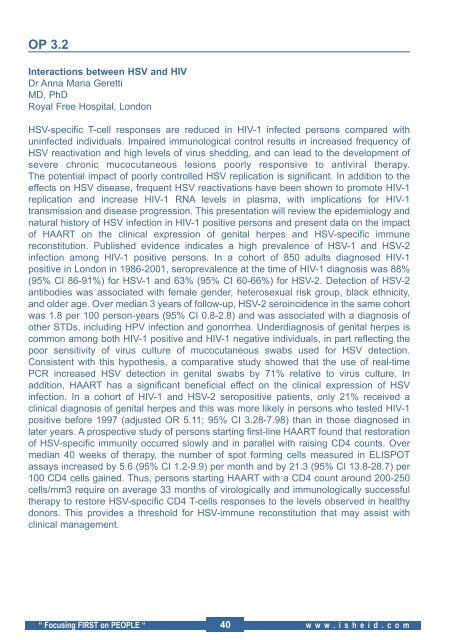final program.qxd - Parallels Plesk Panel
final program.qxd - Parallels Plesk Panel
final program.qxd - Parallels Plesk Panel
You also want an ePaper? Increase the reach of your titles
YUMPU automatically turns print PDFs into web optimized ePapers that Google loves.
OP 3.2<br />
Interactions between HSV and HIV<br />
Dr Anna Maria Geretti<br />
MD, PhD<br />
Royal Free Hospital, London<br />
HSV-specific T-cell responses are reduced in HIV-1 infected persons compared with<br />
uninfected individuals. Impaired immunological control results in increased frequency of<br />
HSV reactivation and high levels of virus shedding, and can lead to the development of<br />
severe chronic mucocutaneous lesions poorly responsive to antiviral therapy.<br />
The potential impact of poorly controlled HSV replication is significant. In addition to the<br />
effects on HSV disease, frequent HSV reactivations have been shown to promote HIV-1<br />
replication and increase HIV-1 RNA levels in plasma, with implications for HIV-1<br />
transmission and disease progression. This presentation will review the epidemiology and<br />
natural history of HSV infection in HIV-1 positive persons and present data on the impact<br />
of HAART on the clinical expression of genital herpes and HSV-specific immune<br />
reconstitution. Published evidence indicates a high prevalence of HSV-1 and HSV-2<br />
infection among HIV-1 positive persons. In a cohort of 850 adults diagnosed HIV-1<br />
positive in London in 1986-2001, seroprevalence at the time of HIV-1 diagnosis was 88%<br />
(95% CI 86-91%) for HSV-1 and 63% (95% CI 60-66%) for HSV-2. Detection of HSV-2<br />
antibodies was associated with female gender, heterosexual risk group, black ethnicity,<br />
and older age. Over median 3 years of follow-up, HSV-2 seroincidence in the same cohort<br />
was 1.8 per 100 person-years (95% CI 0.8-2.8) and was associated with a diagnosis of<br />
other STDs, including HPV infection and gonorrhea. Underdiagnosis of genital herpes is<br />
common among both HIV-1 positive and HIV-1 negative individuals, in part reflecting the<br />
poor sensitivity of virus culture of mucocutaneous swabs used for HSV detection.<br />
Consistent with this hypothesis, a comparative study showed that the use of real-time<br />
PCR increased HSV detection in genital swabs by 71% relative to virus culture. In<br />
addition, HAART has a significant beneficial effect on the clinical expression of HSV<br />
infection. In a cohort of HIV-1 and HSV-2 seropositive patients, only 21% received a<br />
clinical diagnosis of genital herpes and this was more likely in persons who tested HIV-1<br />
positive before 1997 (adjusted OR 5.11; 95% CI 3.28-7.98) than in those diagnosed in<br />
later years. A prospective study of persons starting first-line HAART found that restoration<br />
of HSV-specific immunity occurred slowly and in parallel with raising CD4 counts. Over<br />
median 40 weeks of therapy, the number of spot forming cells measured in ELISPOT<br />
assays increased by 5.6 (95% CI 1.2-9.9) per month and by 21.3 (95% CI 13.8-28.7) per<br />
100 CD4 cells gained. Thus, persons starting HAART with a CD4 count around 200-250<br />
cells/mm3 require on average 33 months of virologically and immunologically successful<br />
therapy to restore HSV-specific CD4 T-cells responses to the levels observed in healthy<br />
donors. This provides a threshold for HSV-immune reconstitution that may assist with<br />
clinical management.<br />
“ Focusing FIRST on PEOPLE “ 40 w w w . i s h e i d . c o m
















